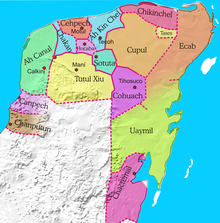Hocabá-Homún
Hocabá-Homun or Hocabá was a Principality ( Mayathan kuchkabal ) of Maya on the Yucatan during the Postclassic that until the time of the Conquista had inventory.
history
The province of Hocabá borrowed its name from the capital of the territory, the seat of Halach Huinik . The ruling family who established territorial rule there after the fall of Mayapán , around the middle of the 15th century, was called Iuit , the name ( Nahuatl : spring ) after presumably descendants of the Maya Toltecs .
At the beginning of the Reconquista , Hocabá was ruled by Nadzul Iuit, a very bellicose prince who waged war against all neighboring jurisdictions ( Chepech , Ah Kin Chel , Sotuta , Mani and Chakán ). Only with Ah Kin Chel did peaceful relations exist at times. His successor and likely son was Francisco Namon Iuit, who was named in a document as governor of the city or province from 1562 to 1565. The Iuit, and with them Hocabá, received the Spaniards in a friendly manner. So the Iuit were able to hold their socio-economic position for the time being and in return supported the Spaniards in the conquest and pacification of the Yucatán, for example against Nachi Cocom and Sotuta. In 1572, however, the indigenous Hidalgo Lorenzo Cen was named as the governor of Hocabá . The church in Hocabá is built on a platform about two meters high, which is assumed to be the structural remainder of the former central temple.
Other cities that belonged to the Hocabás domain were Cuzamá, Hoctum, Hommun, Huhi, Sahcaba, Sanajcat, Seye, Tahmek, Tixcamahel, Xbalché and Xocchel.
At the end of the 17th and 18th centuries, leadership positions such as city governor or cacique were occupied by indigenous nobles. In the late 17th century, Hernando Yah was named as the Kazike and in 1778 Francico Tun as the owner in Hocabá.
Franciscan Church in Hocabá
literature
- Ralph L. Roys : The Political Geography of the Yucatan Maya. Washington 1957, pp. 55-60
- Robert Patch: Maya and Spaniard in Yucatan: 1648 - 1812 , Stanford 1993 (preview on Google Books)


